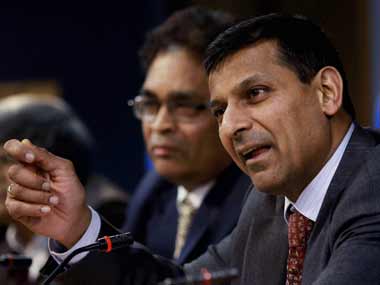Raghuram Rajan’s latest prescription for the economy - a hike in interest rates - is bad news for households who will have to pay higher EMIs for houses and cars. For consumers, it certainly won’t be the happiest Diwali in recent years. For corporates, who may have to try hard to recall the boom years, the rising cost of borrowing simply adds another reason to not invest in the flagging India story.
For the ruling UPA, Rajan’s prescription, as much as his prognosis, are a frightening tolling of the alarm bells, which are only likely to stop ringing after a new Government is sworn into office in around six months’ time.
Rajan’s outlook for next six months, also the last months of UPA’s second term, is simple: Growth is going to be squeezed and inflation is going to linger. India will continue to experience stagflation as voters begin to cast their votes for the 15th Lok Sabha sometime in April 2014.
[caption id=“attachment_1137679” align=“alignleft” width=“380”]  Rajan’s outlook for next six months, also the last months of UPA’s second term, is simple: Growth is going to be squeezed and inflation is going to linger. India will continue to experience stagflation as voters begin to cast their votes for the 15th Lok Sabha sometime in April 2014. PTI[/caption]
The RBI’s policy agenda is amply clear. After two successive rate hikes in less than two months since Rajan took over as Governor, he has signalled his hawkish intent to beat down inflation even if it means sacrificing growth. The bad news for the government is that Rajan’s hammer (interest rates) will only have a limited impact on inflation.
The fact remains that inflation is still being driven by the prices of agricultural commodities - food price inflation went up to a three year high of 18.4 percent in September - and to put it crudely, interest rates are a crude instrument to target onion prices.
What is certain is that growth will hover between 4 and 5 percent. Consumption expenditure is under a double squeeze - of higher interest rates and high inflation. Investment expenditure is under several squeezes: high interest rates, high fiscal deficit, slow project clearances and a climate of distrust between government and industry what with FIRs being filed against prominent members of industry.
Rajan would like the government to address some of those issues urgently, but an election-bound government is not likely to rein in its fiscal deficit (populism in front) nor is it likely to speed up clearances (bureaucrats are wary of taking decisions after the PC Parakh FIR). In short, there are no silver linings.
There are some dark clouds. The US Federal Reserve could potentially begin to roll back its quantitative easing policy sometime in the next six months which could lead to another bout of capital outflows and a weak rupee.The already weakUnion government will become even weaker if the Congress is routed in thefour major assembly elections due next month.
It would require extraordinary fortune for an incumbent government with such an awful economic record to win re-election. Raghuram Rajan will almost certainly not be putting his money on UPA’s re-election.


)
)
)
)
)
)
)
)
)



